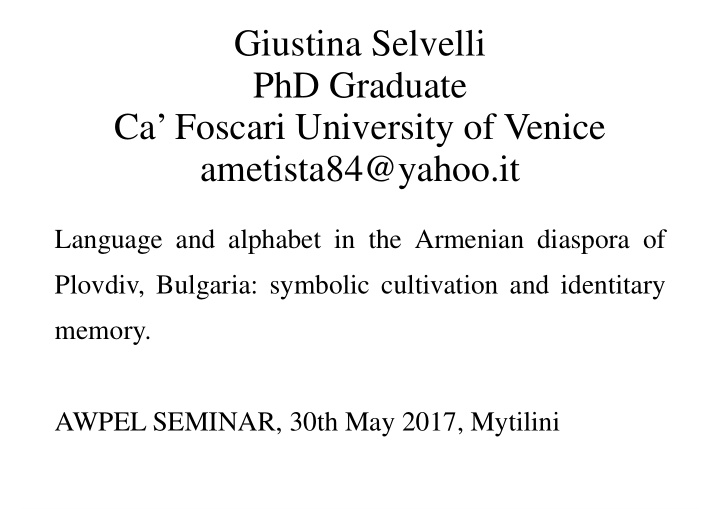



Giustina Selvelli PhD Graduate Ca’ Foscari University of Venice ametista84@yahoo.it Language and alphabet in the Armenian diaspora of Plovdiv, Bulgaria: symbolic cultivation and identitary memory. AWPEL SEMINAR, 30th May 2017, Mytilini
Language, symbols and memory in the Armenian Diaspora
10-month ethnographic fieldwork in the city of Plovdiv, Bulgaria
Anthropological/ethnographic approach to writing systems: Giorgio Raimondo Cardona (1943-1988): - The Anthropology of Writing (1981) - Universal History of Writing (1986) (in Italian) David Barton, Uta Papen: - The Anthropology of Writing. Understanding Textually Mediated Worlds (2010)
Sociolinguistic approach to writing systems’ analysis: In the Southeast European context: � Greenberg, R., “Language and Identity in the Balkans: Serbo-Croatian and Its Disintegration”, 2004 � Bugarski, R., “Language from peace to war” (“Jezik od mira do rata”, in Serbo-Croatian) (1994), “Language in social crisis” (“Jezik u društvenoj krizi”) (1997), “Script” (“Pismo”) (1996).
Other sociolinguistic approaches to writing systems: � Fishman, J., (ed.) “Advances in the creation and revision of Writing systems” (1977). � Sebba, M., “Ideology and Alphabets in the former USSR” (2006), “Sociolinguistic approaches to writing systems research” (2009), “Orthography as social action. Scripts, spelling, identity and power” (2012). � Wellish, H., “The conversion of scripts. Its nature, history and utilization” (1978).
Glagolitic alphabet (864 A.D.)
Georgian alphabet (430 A.D.)
Ge’ez alphabet (6th–5th century BC)
The current Armenian Diaspora
Armenians in Plovdiv
The diaspora: transnational and “transtemporal”
Great Armenia in the space of memory
The plate at the entrance of the school
The Armenian School Victoria and Krikor Tiutiunjian
The “Golden” alphabet plate
Mesrop Mashtots, the inventor of the Armenian alphabet
Symbols of belonging at the Armenian school
The local bi-weekly newspaper “Parekordzagan Tzain”
The alphabet in the “private” space of inscription
“Commodification” of the alphabet?
From graphic system to aesthetic element:
The “aesthetic” rhetoric on the alphabet
The Armenian Apostolic Church “Surp Kevork”
The Armenian Apostolic Church “Surp Kevork”
Inscription of the public space
The Monument to the memory of the Genocide
The crypt of the Church and the “Genocide memorial”
The power of objects at the little “Genocide museum”
Objects from a lost dimension
Objects from a lost dimension
Objects from a lost dimension
Objects from a lost dimension
The Armenian graveyard
First Armenian tombstones (1880s)
The tombstones with spelling mistakes:
Two different orthographies
Three (or more) different orthographies
“Communist” tombstones
Alphabet as one of the most effective symbols of Armenianness
Recommend
More recommend